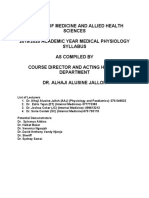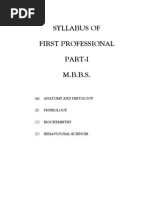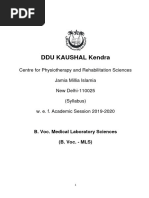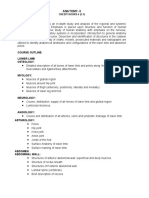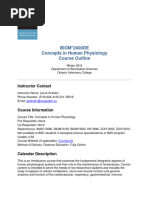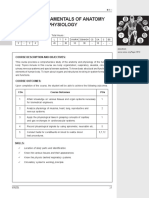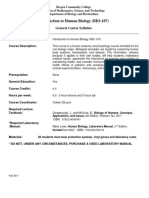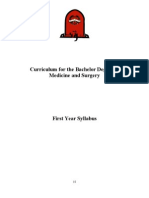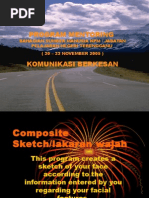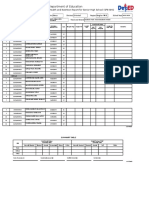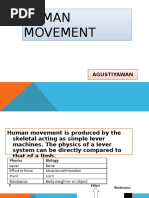0 ratings0% found this document useful (0 votes)
7 viewsHuman Phsiology
Human Phsiology
Uploaded by
sufiyanadamCopyright:
© All Rights Reserved
Available Formats
Download as DOCX, PDF, TXT or read online from Scribd
Human Phsiology
Human Phsiology
Uploaded by
sufiyanadam0 ratings0% found this document useful (0 votes)
7 views3 pagesCopyright
© © All Rights Reserved
Available Formats
DOCX, PDF, TXT or read online from Scribd
Share this document
Did you find this document useful?
Is this content inappropriate?
Copyright:
© All Rights Reserved
Available Formats
Download as DOCX, PDF, TXT or read online from Scribd
Download as docx, pdf, or txt
0 ratings0% found this document useful (0 votes)
7 views3 pagesHuman Phsiology
Human Phsiology
Uploaded by
sufiyanadamCopyright:
© All Rights Reserved
Available Formats
Download as DOCX, PDF, TXT or read online from Scribd
Download as docx, pdf, or txt
You are on page 1of 3
Course information-Human Physiology
Department Sport Science
Program BSc Degree in Sport Science
Course Title Human Physiology
Course Code Bio Med-2724
Credit Hours 3
Contact Hours 3
Year II,
Semester II
Prerequisite Human Anatomy
Course description
This course is to be delivered to Sport Science students following the Human Anatomy course. In principle,
anatomy and physiology courses are hardly separable. Keeping this in mind, this course is designed to address
concepts on; the physiological definitions; basic cellular functions; physiology related to the integumentary
system, the skeletal system, the muscular system, the nervous system and sense organs, the endocrine system,
the digestive system, the endocrine system, the reproductive system, the cardiovascular system, excretion and
osmoregulation and the reproductive system.
Course objectives
At the end of this course the students will be able to:
Define physiology and its sub-disciplines
Define homeostasis, explain how it is achieved and discuss how the various body systems contribute to
the attainment of homeostasis.
Discuss the basic cellular functions.
Discuss the major and additional biological roles of each of the various body systems.
Discuss the role of physical exercise towards the healthy functioning of each body system.
Explain how each of the body systems relates to physical exercise.
Course Contents
Unit 1: Introduction
1.1. Definition and Sub disciplines
1.2. Homeostasis
1.3. Introduction to cell physiology
1.3.1. Basic cellular functions
1.3.2. Cellular metabolism
Unit 2: Integumentary System
2.1. Skin tissues and their functions
2.2. General functions of integumentary system
2.3. Effects of ageing and diseases
Unit 3: The Skeletal System
3.1. Bone tissue and its functions
3.2. Blood supply system to bone tissue
3.3. Joints and their functions
Unit 4: The Muscular System
Types and properties of muscle tissues
4.2. Mechanism of muscle contraction
4.3. Types of muscle movements
4.4. Skeletal muscles and exercise
Unit 5: The Nervous System and the Major Sense Organs
5.1. The Nervous System
5.1.1. Composition of nerve tissue
5.1.2. Nerve impulse
5.1.3. Division of nervous system
The CNS (Spinal cord and Brain)
Peripheral Nervous System (PNS)
5.2. The Major Sense Organs
Unit 6: The Endocrine System
6.1. The Endocrine glands
6.2. Major endocrine hormones and their functions
Unit 7: The Digestive System
7.1. Definition of terms
7.2. The Digestive system
7.2.1. Digestion in the mouth
7.2.2. On the way to the stomach: the esophagus
7.2.3. Digestion and absorption in the stomach
7.2.4. Digestion in the small intestine
Absorption in small intestine
7.2.6. Large intestine
7.3. How is the digestive process controlled?
Unit 8: The Respiratory System
8.1. Respiratory components and their functions
8.2. The processes of inhalation and exhalation
8.3. The mechanisms of gaseous exchange
8.4. Carbon dioxide and Oxygen transport in the blood
8.5. Effects of altitude on breathing
8.6. Human lung capacities
8.7. Diseases of respiratory system
Unit 9: The Cardio-Vascular System
9.1. Functions of cardio-vascular system
9.2. Blood cells and their functions
9.3. Types of circulation
9.4. Cardiac output
9.5. Cardiac cycle
9.6. Regulation of the cardiac cycle
9.7. Blood pressure
9.8. Diseases of the cardio-vascular system
Unit 10: Excretion and Osmoregulation
10.1. General function of the kidney
10.2. Nephrons
10.3. Formation of Urine
10.4. Maintaining Water-Salt Balance
10.5. Renal regulation
10.6. Diseases of the Kidney
Unit 11: The Reproductive System
11.1. Functions of the reproductive system
11.2. Male reproductive system
11.2.1.1. Female Reproductive system
11.2.1.2. The Menstrual cycle
11.3. Sexually transmitted diseases (STDs)
Teaching Methods/Strategies:
Lecture,
discussion,
individual or group project,
independent reading,
Assignments.
Students’ activities
Participation in discussions,
attending lab sessions and classes,
preparation and submission of laboratory reports,
obeying rules
Assessment strategiesand techniques
Continuous assessment 10%
Mid – examination 30%
Project/Lab report 10%
Final exam 50%
Total 100%
Reference
Fox (2002). Human Physiology Lab Manual, 9th ed. McGraw-Hill Companies, Inc, USA
Netter‘s Atlas of Human by Physiology by Hansen, J. T. and Koeppen, B.M.
Robert, S. (2007). Human Physiology, Global Media, Delhi
Roddie, I. C. and William F.M. W. (2004). MCQ‘s and EMQ‘s in
human physiology, 6th ed., Arnold, a member of the Hodder Headline Group, Great Britain.
Rogers, K. (2011).The Eye: The physiology of human perception, Encyclopedia Britannica, New York
Van De Graaff, K.M., Rhees, R.W. and Palmer, S. (2010).Human Anatomy and Physiology.Schaum‘s
Outlines, 3rd ed. McGraw- Hill Companies, Inc, USA
Vander et al. (2001). Human Physiology: The Mechanism of Body Function, 8th ed. McGraw-Hill
Companies, Inc, USA
You might also like
- Full Download Ebook PDF Maders Understanding Human Anatomy Physiology 10th Edition 2 PDFDocument41 pagesFull Download Ebook PDF Maders Understanding Human Anatomy Physiology 10th Edition 2 PDFkay.mcguire8860% (1)
- Encircled - The Minimalist Wardrobe WorkbookDocument18 pagesEncircled - The Minimalist Wardrobe Workbookmeaghankd100% (5)
- Guyton Hall PHYSIOLOGY Chapter 1 PDFDocument3 pagesGuyton Hall PHYSIOLOGY Chapter 1 PDFOsman Nazir100% (1)
- Human Anatomy and Physiology Course OutlineDocument16 pagesHuman Anatomy and Physiology Course OutlineDEVORAH CARUZ100% (2)
- The Physical Therapy Licensure Examination Syllabus (Philippines) )Document14 pagesThe Physical Therapy Licensure Examination Syllabus (Philippines) )Xy Flores100% (1)
- A&P 1 2016 Course OutlineDocument22 pagesA&P 1 2016 Course OutlinewizzieeNo ratings yet
- Book List of ENTDocument6 pagesBook List of ENTLAKSHIT KUMARNo ratings yet
- Wa0086Document8 pagesWa0086JosephNo ratings yet
- BIOL181Document13 pagesBIOL181Mark Dwayne Cyrus IINo ratings yet
- 1st Year BHMS - 2015-1Document17 pages1st Year BHMS - 2015-1Ketan PanditNo ratings yet
- Teaching Plan-Anat Physio 1 2013 FinalDocument4 pagesTeaching Plan-Anat Physio 1 2013 Finalதுர்காஸ்ரீ கங்கா ராதிகாNo ratings yet
- Mbbs Part 1 Uhs SyllabusDocument14 pagesMbbs Part 1 Uhs SyllabusMudassar Roomi100% (1)
- 1biological ScienceDocument3 pages1biological Sciencemika10egaNo ratings yet
- CHD 121 Anatomy and Physiology Course OutlineDocument2 pagesCHD 121 Anatomy and Physiology Course Outlinemalenya1No ratings yet
- Cs Ddukk MLSDocument31 pagesCs Ddukk MLSPriyank JainNo ratings yet
- 2nd Semester ContentsDocument13 pages2nd Semester ContentspashaNo ratings yet
- physiology-learning-obj-and-syllabus-26-04-17Document10 pagesphysiology-learning-obj-and-syllabus-26-04-17anujkumar1cocNo ratings yet
- BSN 112 Medical physiology 1 course outline revised september 2024-1Document3 pagesBSN 112 Medical physiology 1 course outline revised september 2024-1evansprince846No ratings yet
- Rad AnaDocument4 pagesRad AnaKurt Izen OrtegaNo ratings yet
- Human Anatomy PhysiologyDocument3 pagesHuman Anatomy PhysiologyHammad AliNo ratings yet
- Being A Medical Student and Locomotor System 1Document28 pagesBeing A Medical Student and Locomotor System 1Muhammad Zaniar RamadhaniNo ratings yet
- Syllabus of 1st Internal Exam MBBS 2023Document3 pagesSyllabus of 1st Internal Exam MBBS 2023wnh4rpky5rNo ratings yet
- Course Plan - HAP 1Document7 pagesCourse Plan - HAP 1Suraj PatilNo ratings yet
- MD Physiology 1Document13 pagesMD Physiology 1arunadavis3No ratings yet
- Biom2000de W16Document23 pagesBiom2000de W16DD IS COOLNo ratings yet
- HCM 112 Medical Physiology Course OutlineDocument4 pagesHCM 112 Medical Physiology Course Outlineyvonneisah02100% (1)
- Hem 704Document110 pagesHem 704uchemichael2701No ratings yet
- Homoeopathy Ayush DepartmentdDocument21 pagesHomoeopathy Ayush DepartmentdpvniyedlaNo ratings yet
- Chapter 1 The Human OrganismDocument18 pagesChapter 1 The Human OrganismEuniece AnicocheNo ratings yet
- BPT Syllabus PDFDocument99 pagesBPT Syllabus PDFAbhishek NegiNo ratings yet
- 4 Human Anatomy and Physiology (2220004)Document4 pages4 Human Anatomy and Physiology (2220004)Shrinidhi AcharyaNo ratings yet
- Being A Medical Student and Locomotor SystemDocument22 pagesBeing A Medical Student and Locomotor SystemIffan IkhsanantoNo ratings yet
- Gujarat Technological University: B.Pharm Semester: IDocument3 pagesGujarat Technological University: B.Pharm Semester: IRanjan MajhiNo ratings yet
- BIOL360 Human Physiology - AnatomyDocument3 pagesBIOL360 Human Physiology - Anatomyadeeb ahmedNo ratings yet
- BBMD101L - Anatomy-And-Physiology - TH - 1.0 - 71 - BBMD101L - 66 AcpDocument2 pagesBBMD101L - Anatomy-And-Physiology - TH - 1.0 - 71 - BBMD101L - 66 AcpAahan JainNo ratings yet
- Fundamentals of Anatomy and Physiology: Course Description and ObjectivesDocument3 pagesFundamentals of Anatomy and Physiology: Course Description and Objectivesvamsi karna100% (1)
- PhysiologyDocument12 pagesPhysiologyrajan guptaNo ratings yet
- Physiology (CBME)Document61 pagesPhysiology (CBME)Ishan SharmaNo ratings yet
- BML PhysiologyDocument4 pagesBML PhysiologykhakzwazNo ratings yet
- Endocrine System-1 StudyGuide 2022Document7 pagesEndocrine System-1 StudyGuide 2022muhammad umer abdul moizNo ratings yet
- Bio 107Document11 pagesBio 107lizawillam2023No ratings yet
- Curriculum For The Bachelor Degree in Medicine and SurgeryDocument21 pagesCurriculum For The Bachelor Degree in Medicine and SurgeryIbrahim00No ratings yet
- B Pharmacy SyllabusDocument189 pagesB Pharmacy SyllabusSatyam SachanNo ratings yet
- SyllabusDocument2 pagesSyllabusSantino AwetNo ratings yet
- First Year MBBSDocument25 pagesFirst Year MBBSTofik MohammedNo ratings yet
- PhysiologyDocument18 pagesPhysiologyAbhishek PawarNo ratings yet
- Physiology 090819Document21 pagesPhysiology 090819sanjayrathodsr564No ratings yet
- 4444444412Document5 pages4444444412Demiar Madlansacay QuintoNo ratings yet
- Elements of Human BiologyDocument182 pagesElements of Human BiologyGayathriNo ratings yet
- Scope of AnatomyDocument25 pagesScope of Anatomymr12323No ratings yet
- Syllabus-Advanced PhysiologyDocument4 pagesSyllabus-Advanced PhysiologyJa NetNo ratings yet
- COURSE PLAN Apllied Physiology B.SCDocument8 pagesCOURSE PLAN Apllied Physiology B.SCDesai AasthaNo ratings yet
- COURSE PLAN Apllied Physiology B.SCDocument8 pagesCOURSE PLAN Apllied Physiology B.SCastha.desaiNo ratings yet
- Syllabus 2sem - Norm - Physiology - 2024 - StudentsDocument16 pagesSyllabus 2sem - Norm - Physiology - 2024 - StudentsNavneet KumarNo ratings yet
- Sofia Ngo DMLT CourseDocument3 pagesSofia Ngo DMLT Coursesanjeevkr3770No ratings yet
- Basics of Anatomy & PhysiologyDocument110 pagesBasics of Anatomy & PhysiologyDurga Prasad P83% (6)
- Sports Science and NutritionDocument40 pagesSports Science and NutritionMuthu KumaranNo ratings yet
- 1 IntroDocument53 pages1 Introcharlih1517No ratings yet
- 0.2study Guide MSK321. Males. (2022-2023)Document82 pages0.2study Guide MSK321. Males. (2022-2023)truch 2022No ratings yet
- Introduction To The Human BodyDocument30 pagesIntroduction To The Human BodyShin YuNo ratings yet
- Biomedical Sciences: Essential Laboratory MedicineFrom EverandBiomedical Sciences: Essential Laboratory MedicineRaymond IlesNo ratings yet
- Advancements in Cardiovascular Research and Therapeutics: Molecular and Nutraceutical PerspectivesFrom EverandAdvancements in Cardiovascular Research and Therapeutics: Molecular and Nutraceutical PerspectivesNo ratings yet
- Overcoming Gravity 2nd Edition Exercise Charts - Sheet1 PDFDocument20 pagesOvercoming Gravity 2nd Edition Exercise Charts - Sheet1 PDFCyrilNo ratings yet
- Lower Body Stretch: Instructions Example Hip/Glute StretchDocument9 pagesLower Body Stretch: Instructions Example Hip/Glute StretchTs. Dr. Ramu Velusamy100% (1)
- Blood VesselsDocument13 pagesBlood VesselsAmy JessyNo ratings yet
- Earth & Life Science Q2 - W - 5-7: Week 5: Organ Systems of Representative AnimalsDocument7 pagesEarth & Life Science Q2 - W - 5-7: Week 5: Organ Systems of Representative AnimalsAira Manuba MozoNo ratings yet
- Velicine Obuca PDFDocument1 pageVelicine Obuca PDFMilan DanilovicNo ratings yet
- LIBRARY RECORDxlsxDocument148 pagesLIBRARY RECORDxlsxAnonymous naEAR9adNo ratings yet
- Fashion CycleDocument23 pagesFashion Cyclenavkaler151No ratings yet
- Case Study - Dengue Fever V - S UtiDocument12 pagesCase Study - Dengue Fever V - S UtiHarlene Joyce ReyNo ratings yet
- Komunikasi BerkesanDocument41 pagesKomunikasi BerkesanJamaliah AhmadNo ratings yet
- Intro To Physiology 1Document53 pagesIntro To Physiology 1Lemma Deme ResearcherNo ratings yet
- HTTPS://WWW - Scribd.com/presentation/332117871/mga Uri NG Tekstong ImpormatiboDocument2 pagesHTTPS://WWW - Scribd.com/presentation/332117871/mga Uri NG Tekstong ImpormatiboRegine AbilarNo ratings yet
- Principles of Organisation 1 ScienseDocument9 pagesPrinciples of Organisation 1 ScienseMaría Lau WongNo ratings yet
- Fitt 1 Hand OutDocument9 pagesFitt 1 Hand OutVhea LeynesNo ratings yet
- Human Organ Trading CardsDocument2 pagesHuman Organ Trading Cardsapi-365614557No ratings yet
- School Form 8 (SF 8)Document2 pagesSchool Form 8 (SF 8)Miriam Datinggaling0% (1)
- Introduction To Normal PhysiologyDocument51 pagesIntroduction To Normal PhysiologyAshish SingrohaNo ratings yet
- Human MovementDocument35 pagesHuman MovementdellanadiyaNo ratings yet
- Chicken Anatomy & PhysiologyDocument26 pagesChicken Anatomy & PhysiologySanjeev ChaudharyNo ratings yet
- Expenses PlanDocument4 pagesExpenses Planarchipelcreatif.idNo ratings yet
- Urinary System-WPS OfficeDocument21 pagesUrinary System-WPS OfficeMario Sr. SumpoNo ratings yet
- Developmental StretchingDocument11 pagesDevelopmental StretchingSuzanne BowenNo ratings yet
- Quiz Grade 4&5 NewDocument20 pagesQuiz Grade 4&5 NewSam RenuNo ratings yet
- Syllabus Affiliated Medical B.SC .MLT2020-21Document89 pagesSyllabus Affiliated Medical B.SC .MLT2020-21parthmishra265No ratings yet
- Ease in PatternsDocument6 pagesEase in PatternsDamaris GNo ratings yet
- Eat Well, Live Well - PDF RoomDocument267 pagesEat Well, Live Well - PDF Roomnaps100% (1)
- Earth and Life Science SLHT 5Document7 pagesEarth and Life Science SLHT 5mae amor cedenioNo ratings yet
- Solved CMAT 2021 Slot 2 Paper With SolutionsDocument37 pagesSolved CMAT 2021 Slot 2 Paper With SolutionsAnshul BhallaNo ratings yet







